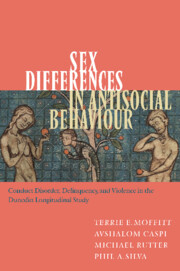 Sex Differences in Antisocial Behaviour
Sex Differences in Antisocial Behaviour Published online by Cambridge University Press: 22 September 2009
How stable is antisocial behaviour? Even in the 1970s, during the heyday of ‘situationism’ in psychology, behavioural scientists acknowledged that individual differences in aggressive behaviour are stable (Olweus, 1979). Longitudinal studies completed both before and after Olweus' review showed that antisocial behaviour was predictable from one point in time to another (e.g., Huesmann et al., 1982; Farrington, 1986; Macfarlane, Allen, and Honzik, 1954; Stattin and Magnusson, 1991b; Pulkinnen and Pitkanen, 1993; Patterson, Reid, and Dishion, 1992; Stanger, Achenbach, and Verhulst, 1997). However, most of the studies of the stability of antisocial behaviour have examined only males because historically few longitudinal studies of antisocial behaviour have sampled girls; in fact, the two most oftcited authoritative reviews on the topic of the stability of antisocial behaviour reviewed studies of males only (Loeber, 1982; Olweus, 1979). Some authors state that antisocial behaviour is less stable and predictable among females than among males (e.g., Cairns and Cairns, 1984; Moss and Susman, 1980), while other authors state that there is no reliable sex difference in the stability of antisocial behaviour (Cairns and Cairns, 1994; Tremblay et al., 1992). In our reading of the literature, we were impressed at how often each view was stated with confidence. Both cannot be correct.
The goal of this chapter is to test whether antisocial behaviour is equally stable from childhood to adolescence to adulthood in both males and females.
To save this book to your Kindle, first ensure [email protected] is added to your Approved Personal Document E-mail List under your Personal Document Settings on the Manage Your Content and Devices page of your Amazon account. Then enter the ‘name’ part of your Kindle email address below. Find out more about saving to your Kindle.
Note you can select to save to either the @free.kindle.com or @kindle.com variations. ‘@free.kindle.com’ emails are free but can only be saved to your device when it is connected to wi-fi. ‘@kindle.com’ emails can be delivered even when you are not connected to wi-fi, but note that service fees apply.
Find out more about the Kindle Personal Document Service.
To save content items to your account, please confirm that you agree to abide by our usage policies. If this is the first time you use this feature, you will be asked to authorise Cambridge Core to connect with your account. Find out more about saving content to Dropbox.
To save content items to your account, please confirm that you agree to abide by our usage policies. If this is the first time you use this feature, you will be asked to authorise Cambridge Core to connect with your account. Find out more about saving content to Google Drive.